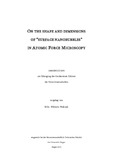Zitierlink:
https://nbn-resolving.org/urn:nbn:de:hbz:467-8342Dateien zu dieser Ressource:
| Datei | Beschreibung | Größe | Format | |
|---|---|---|---|---|
| Dissertation_Walczyk_Wiktoria.pdf | 49.28 MB | Adobe PDF |  Öffnen/Anzeigen |
| Dokumentart: | Doctoral Thesis | Titel: | On the shape and dimensions of "surface nanobubbles" in atomic force microscopy Die Form und Dimensionen der "Oberflächennanoblasen" in der Rasterkraftmikroskopie |
AutorInn(en): | Wałczyk, Wiktoria | Institut: | Fakultät IV - Naturwissenschaftlich-Technische Fakultät | Schlagwörter: | nanobubbles, atomic force microscopy | DDC-Sachgruppe: | 540 Chemie | GHBS-Notation: | UIQN UUO UZS VNUK |
Erscheinungsjahr: | 2014 | Publikationsjahr: | 2014 | Zusammenfassung: | Nanoscopic gas bubbles on surfaces immersed in water, investigated in this thesis, termed “surface nanobubbles”, with diameters hundred times smaller than the diameter of a human hair and ten times smaller than the diameter of a red blood cell belong to the realm of nanoscale. Since surface nanobubbles involve three phases, i.e. gas, liquid and solid, they present an excellent system to study wetting of surfaces on the nanoscale, which becomes increasingly important in nanotechnology, biology and other fields. The work presented in this thesis aimed toward a better understanding of the role of Atomic Force Microscopy (AFM), which is the technique that is commonly used to investigate surface nanobubbles, in the outcome of the analysis of the shape and dimensions of nanobubbles. In particular, it is highly necessary to recognize the discrepancy between the apparent nanobubble shape visible in AFM images and the actual unperturbed shape of nanobubbles. This issue is particularly important because the knowledge about actual nanobubble curvature and contact angle is crucial for solving the puzzle of the long-term stability of nanobubbles, which would undoubtedly accelerate current research in the field. Bringt man Oberflächen in Kontakt mit Wasser, bilden sich nanoskopische Gasblasen, sogenannte Oberflächennanoblasen („Surface Nanobubbles“), die in dieser Arbeit untersucht wurden. Mit einem Durchmesser hundertmal kleiner als der des menschlichen Haares und zehnmal kleiner als der roter Blutkörperchen gehören sie zum Nanokosmos. Da an Oberflächennanoblasen Grenzflächen der drei Phasen Gas, Flüssigkeit und Feststoff auftreten, bilden sie ein ideales System zum Studium der Benetzbarkeit von Oberflächen auf der Nanoebene – einer Thematik von zunehmender Bedeutung für die Nanotechnologie, Biologie und anderer Bereiche. Das Ziel der in dieser Dissertation durchgeführten Arbeiten ist ein besseres Verständnis der Rasterkraftmikroskopie (AFM) und der Auswirkung verschiedener Messparameter auf die apparenten Dimensionen der Nanoblasen. Dies ist von besonderer Bedeutung, da die mittels AFM gewonnen Daten die Basis für die Berechnung der Krümmungsradien und Kontaktwinkel der Nanoblasen bilden. Aus diesen Parametern ergeben sich bislang nicht zufriedenstellend beantwortete Fragen nach der unerwartet langen Lebensdauer der Nanoblasen, so dass eine grundlegende Überprüfung der experimentellen Befunde einer weiteren theoretischen Betrachtung vorausgehen muss. |
Beschreibung: | Kumulative Dissertation |
URN: | urn:nbn:de:hbz:467-8342 | URI: | https://dspace.ub.uni-siegen.de/handle/ubsi/834 | Lizenz: | https://dspace.ub.uni-siegen.de/static/license.txt |
| Enthalten in den Sammlungen: | Hochschulschriften |
Diese Ressource ist urheberrechtlich geschützt. |
Seitenansichten
498
checked on 03.04.2025
Download(s)
207
checked on 03.04.2025
Google ScholarTM
Prüfe
Alle Ressourcen in diesem Repository sind urheberrechtlich geschützt, soweit nicht anderweitig angezeigt.

